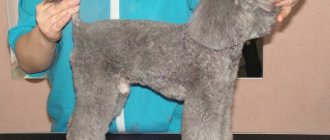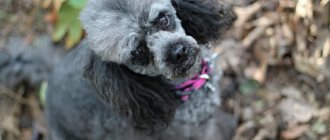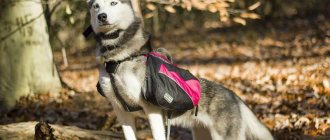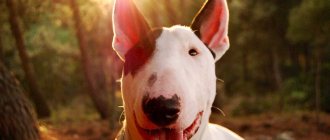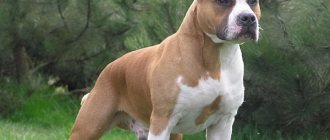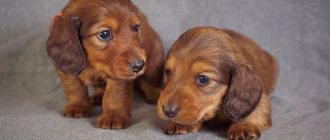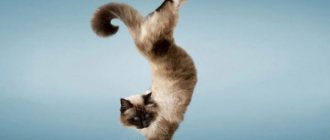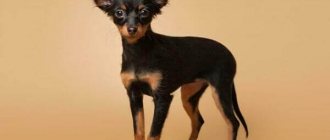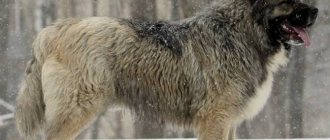Raising a dog is about developing correct behavior. This is the basis for successful training. Training is a set of activities aimed at training specific teams. It is necessary to start raising a puppy from the very first days of his appearance in the house. If you work with your pets from a very early age, then you are on the right track.
Poodles are considered one of the smartest breeds in the world. They are highly trainable. Bored poodles can become destructive if left untrained. But active owners who can meet the needs of Poodles will find a lively, intelligent, trainable and the best companion for the whole family.
- Country of origin : France
- Height at the withers : large 45 – 60 cm, small 35 – 45 cm, dwarf 28 – 35 cm, toy 24 – 28 cm
- Weight : large 20 – 30 kg, small 8 – 14 kg, dwarf 6 – 8 kg, toy ~2.5 kg
- Lifespan : 12-15 years
- Use : companion dog, hunting
- Other names : royal poodle (large poodle)
Puppy care
Before you start training your poodle, it needs to be accustomed to its new environment. Ask the breeder to give you a piece of a sheet with the baby's mother's scent along with the puppy: this way, you will immediately accustom him to a sleeping place. Remember that both the miniature poodle and its full-sized relative are very restless and playful. Your pet may chew your shoes, but you shouldn’t punish him too much for this.
Try to protect your dog from dangerous objects. Training a poodle starts small. To begin with, raise him in obedience and do not take liberties (sleep in bed with you, eat from the table, etc.). At the same time, psychological contact and socialization of the dog are mandatory elements of education.
Punishment
- Censure. The owner expresses dissatisfaction with the pet’s behavior by telling him in a stern tone: “You can’t!”, “Ugh!” or something like: “Who did this?”
- Ignoring. In some cases, for example, when a puppy shows aggression during play, it makes sense for the owner to go to another room and not pay attention to the dog for a while.
- Sending to the place. If a dog is caught committing unwanted actions, it may be sent to its place and will not have to leave it until the owner gives permission.
- Physical impact. Should not include beatings: it is acceptable to lightly spank your pet with a rolled-up newspaper or shake him by the collar, but do not hit him too hard.
Important! The punishment must be proportionate to the offense; it is also unacceptable to punish a dog for no reason, simply because the owner is in a bad mood.
Content Rules
You need to care for your poodle carefully if you want the puppy to grow into a healthy and beautiful dog. First of all, you should pay attention to the condition of the dog’s coat. The structure of a poodle's hair is similar to that of a human, so the pet's coat must be cut, washed and combed regularly. In addition, if the coat is not properly cared for, tangles can form on it.
Similar article: Types and rules for cutting a poodle at home
From time to time it is recommended to cut the poodle with a clipper or scissors. If you wish, you can give your pet a model haircut. The dog's ears need to be regularly cleaned of wax and nails trimmed. Another mandatory point is tail docking. And no one has canceled regular teeth cleaning.
How to do this correctly?
In order for the process of raising a pet to proceed without complications, it is necessary to follow some rules.
From the first day a puppy appears in the house, they begin to teach him a name, keeping the house clean and his place.
Dog owners should immediately determine the limits of what is permissible for their pet. At the same time, it is unacceptable that someone in the household, for example, allows a puppy to sleep on the sofa, while others forbid it. It is also unacceptable to make allowances for the age or physical condition of the pet.
To prevent your pet from chewing on anything necessary from things or furnishings in the house, you need to provide it with suitable toys in a timely manner. And shoes, clothes and other objects that the puppy can chew must be removed before they attract the attention of the little prankster.
Excessive barking from your pet can be a serious problem. In order for the dog not to grow up to be an empty-headed dog, you need to stop all his attempts to bark at passers-by on the street or bark for no reason in the house.
The owner must immediately take a leadership position. A small poodle must firmly know that the main thing in the house is its owner and his family members and that the dog must obey them unquestioningly.
It is necessary to adhere to the sequence: first teach the poodle simpler commands and only after the dog learns to carry them out flawlessly can you move on to more complex ones.
You cannot raise a poodle only with encouragement or solely with the help of punishment. Both of these methods must be alternated.
Each of the actions of a puppy or an adult dog must be accompanied by either reward or punishment.
Important! To prevent caring for a poodle's coat from turning into a serious ordeal, it is necessary to teach the puppy from a very early age to be calm about combing, bathing, shortening nails, and, later, cutting their hair.
What to feed your dog
Feeding this dog is another significant stage in caring for it. What to feed a poodle, and what rules are recommended to follow to organize a balanced diet? You can give preference to both natural products and dry food mixtures.
The main thing is that the products that you include in your four-legged friend’s daily menu contain proteins, fats, carbohydrates, and various vitamins. If you decide to switch your pet exclusively to feeding natural products, 2/3 of the diet will be meat.
Under no circumstances should you give your dog smoked meats, potatoes, chocolate, confectionery, as well as thick cereals and pasta.
We recommend this article:
Basics of healthy pet nutrition or what to feed your dog
Reward methods
- Praise. The owner says words like: “Good!” in an approving tone. or “Well done!” Praise can be accompanied by giving treats or playing.
- Delicacy. Given to the dog during training. Represents a food especially loved by the poodle. As a treat, it is recommended to use either special dog “delicacies” purchased in the store, or pieces of hard cheese, homemade crackers or small unsweetened biscuits.
- A game. As a reward, for example, the dog is allowed to play a little with the fetch item.
Important! It should be remembered that it is not recommended to reward an adult dog with a treat every time a command is executed, since verbal praise is enough for them.
Training and education
How to train a miniature poodle puppy, and where exactly to start? In general, you should not have problems with upbringing. The thing is that the poodle is a true artist by nature. He loves to play with children and just loves everyone's attention. Even in the circus, most people teach various tricks to poodles, training them from an early age. Your key task is to interest your pet in learning: constantly come up with new tricks, and your pet will certainly join the game.
We recommend this article:
Contents and basic principles of dog training
Training Opportunities
The dog must understand all the rules that a human friend needs to know. This breed is excellent at learning orders and has no problem showing what it has learned. Start developing skills with basic commands. Examples would be “lie down”, “sit”, “near”, “fu”.
Give orders in a confident, firm voice, and praise in a softer voice. Orders must be carried out quickly and obediently. The next stage will be getting used to unusual actions. Conduct classes while in a great mood. This will have a positive effect on your training. The poodle remembers a huge amount of expressions and words. He is very smart and quick-witted.
If training is carried out in a playful way, you can get a lot of positive emotions. The poodle loves to frolic with the guys and loves to be completely interested in himself. Your main goal is to keep your pet's attention: constantly invent new techniques, and the puppy will definitely join the game.
Common diseases and vaccinations
How long do poodles live? The lifespan of these animals is quite long: they live for about 12 years. Nevertheless, tail docking, as well as timely vaccinations, are recommendations that should be followed. For example, when a puppy is 2-3 months old, he needs to be vaccinated against distemper and rabies.
Remember: before vaccinating a miniature poodle, it is necessary to cleanse the pet’s body of worms, since their presence will weaken the immune system.
In general, the animal is in good health, but its eyes may often water. If your poodle's eyes are running excessively, he should be taken to the vet immediately.
Similar article: Care and features of keeping a miniature poodle
Owner reviews
“Many people believe that royal poodles are only decorative dogs that belong only on the sofa or in an exhibition. But our two dogs are great at hunting duck or, for example, pheasant. We taught them this without difficulty, since the hunting instinct is in their blood.
The younger dog, by the way, just as easily mastered both OKD and even ZKS, gaining the highest scores and leaving many of the dogs of pure working breeds far behind.”
“Our small poodle masters all commands instantly. He is so smart that he understands everything and can do everything he was taught.
At the same time, it’s not that we didn’t do any training at all, but, it seems to me, we didn’t devote too much time to it due to being busy at work. I think that if we had seriously started training him, he would have easily mastered any of the circus tricks, since he himself loves to learn something and is always happy to play with us.”
“Very friendly and intelligent dogs. In order to teach a dwarf poodle commands, you do not need to contact a trainer: our favorite, for example, learns everything through play. Moreover, what’s interesting is that they even obey a child: her daughter, who is 7 years old, independently taught the dog the commands “Give me a paw” and “Lie down,” which, you see, would hardly be possible with a shepherd dog or even a bulldog.”
“Our toy poodle is an incredibly smart and quick-witted dog. He only needs to say something once for him to understand what is required of him.
We educate him exclusively with words, games and treats: there has never been a case where we had to spank him for any offense. Of course, sometimes it’s mischievous, but what could we do without it? But as soon as you strictly tell him “You can’t!”, he immediately stops acting up and again behaves just perfectly.”
Water procedures and hair care
Docking a small poodle's tail, getting vaccinations on time, preventing your dog's lacrimation - you'll have plenty of tasks to do. In addition to basic care, it is very important to monitor the condition of your pet’s coat. When the puppy is 2 months old, the fur on its face needs to be trimmed a little so that it does not get into its nose and eyes.
Under no circumstances should you bathe your dog until he is six months old. Even if the coat becomes too dirty, use a special shampoo for dry hair. At the end of the water procedures, the pet should be thoroughly dried and then dried with a hairdryer. It is advisable that the puppy get used to noise from an early age, since you cannot do without drying the fur.
Take proper care of your furry four-legged friend: watery eyes need to be treated so that they do not begin to fester, it is advisable to dock the tail at an early age. Do not forget to monitor your pet’s diet, and it will develop to its fullest.
Text of the book “Poodle. Useful tips"
Ilya Melnikov Poodle. Useful tips
Introduction. SHEPHERD, HUNTER, ACTOR, FRIEND
The poodle is one of the oldest dog breeds, although experts continue to debate its origins.
Some claim that it comes from a herding dog, others that it comes from a “water dog” used to serve waterfowl. Undoubtedly, the poodle is the product of crossing these ancient breeds. This is evidenced by the two types of poodle hair: curly (inherited from a shepherd dog) and corded - borrowed from a water dog. The inheritance is also visible in the character of the poodle. He combines the intelligence and energy of a herding dog with a willingness to fetch and a love of water. These features of the poodle were used in the formation of a new breed - the pointer.
The poodle, in the full sense of the word, can be considered a model of a decorative dog, but one should not forget about its “canine” abilities, which lie in its origin. In his veins flows the blood of an Irish water spaniel, descended from French barbets and Hungarian herding dogs. The word "poodle" comes from the German "pudelnass", which means "soaking wet".
Poodles have an excellent sense of smell, they love water, and have an innate hunting passion. They are ideal apporators. Sociable, affectionate, playful and at the same time very brave dogs.
Most poodles have enviable strength of character, endurance, disease resistance and longevity. They are unpretentious, distinguished by their versatility in behavior, and are unusually devoted to their owner. They are friendly and easily get along with other animals - dogs, cats.
Large and medium poodles are ideal nannies and partners in children's games.
The poodle loves affection. They are trained in almost all services. During the war it was used in the mine search, sanitary and communications services. The poodle perfectly fulfills the standards of the protective guard service, they win awards in hunting tests for hare and waterfowl, but the main honors go to the decorative poodle. He shines with equal success in the show rings and keeps company at home for adults and children.
If the reader has a desire to have just such a dog, then all that remains is to warn that, with all its tolerance for our weaknesses, the poodle does not tolerate rough treatment. It requires attention and care, affection, patience and tact from the owner. However, the reader will understand all this as soon as he brings the puppy home, sits him on his lap, and the poodle with his big black eyes begins to study you very carefully. You need to talk to him more often, play, in a word, communicate.
Poodle requires care. It is advisable to comb him once a week, bathe him 1-2 times a month. Once a week you need to inspect and clean your ears. The Poodle is a non-shedding breed and therefore requires grooming, which should be done once every 2-3 months.
Poodles have a wonderful sense of smell. They can be used as search dogs and rescue dogs. In France, they have long been prepared to search for underground mushrooms – truffles – in the forest. Poodles help customs officers detect drugs.
The best evidence of the high merits of the poodle is that, despite the variability of fashion, it has been the most popular breed in the world for many decades.
The poodle can navigate well and find its way home, even if it is at a considerable distance. He can be trained to do many tricks: he will bark on orders, bring you slippers, an umbrella, a bag, even take off your shoes, open and close the door, organize parades with turns left, right and around. In the circus, a poodle shoots a pistol, drums and whistles, and pretends to be sick and drunk. In short, he is a born artist. However, one should not be mistaken about his lack of character. He has character. For example, punishing a poodle will not achieve anything - this is how the poodle “educates” its inept mentor.
The Poodle is often described as the "intelligent" of dogs, and he seems to love it that way. We also appreciate the poodle for its friendliness, playfulness, and willingness to entertain us. He retains these qualities until old age.
In the 17th century, a certain Andreas Pschorer showed “reading and counting” poodles, one of which, in response to a question about the age of the person indicated to him, chose the one that seemed suitable to him from the number plates lying on the bench. Another poodle unerringly found objects that his owner had previously handed out to spectators, who then hid them. This is a trick that “thinking” dogs still perform today.
Shepherd, sailor, hunter, actor, invaluable companion in life - this is the poodle. Moves at ease, confidently, carefully monitoring the surrounding situation. Regardless of size, with his short stride, harmonious and elegant, and his curious gaze, from which nothing escapes, he seems to express a constant joy in being in this world.
To please the owner, he, like a real actor, changes without losing his natural inclinations. From a shepherd he turned first into a sailor, then into a water hunter, and even later into a lap dog. Among indoor breeds, it firmly occupies a leading position.
From its many ancestors - shepherds, sailors, hunters and, finally, family friends - the poodle has inherited incredible adaptability and flexibility, thanks to which it can solve numerous, often unexpected and difficult tasks in a variety of situations.
After he moved away from the village life of the initial period of his development, he firmly integrated into the life of the human family, fully aware of his role in it. The clear preference he shows to the one whom he independently chooses as his leader and head does not make him withdrawn, much less arrogant towards those who live nearby. This dog is respectful, cheerful and creative with everyone, and certainly cannot be called a toy. Breed experts say that a poodle should be judged by what it really is, and not by what it appears to be.
HISTORY OF THE BREED
It’s ironic, but one of the oldest dogs, the poodle, did not have a homeland a hundred years ago. The primacy of the “birth” of the breed was disputed by the French, Germans and Italians. Selincourt in the 17th century was sure that the poodle originated from Piedmont. And the authoritative German naturalist Bram in his famous “History of Animals” defends its German roots.
A well-known Swiss specialist who studies the history of the poodle, Rosa Engler, claims that Central Asia (Tibet, Mongolia) can be considered the ancient homeland of dogs with shaggy hair. Their spread was facilitated by ancient sailors - the Phoenicians, who brought these dogs to the port cities of the Mediterranean.
According to this version, herding dogs first came to North Africa and only then to Europe. Later, under the name “barbet”, these dogs settled in Europe as shepherds of sheep flocks through France. The piquancy of the situation lies in the fact that the probable homeland of the poodle can be considered any place where shaggy shepherd dogs appeared. This explains the difficulty of establishing the country of origin of this breed. Today's poodle has, to a greater or lesser extent, the blood of Russian, Hungarian, Spanish, German or French dogs.
The ancestors of the poodle began to arrive in southern Europe at the beginning of the second millennium with the Moors, then with Mediterranean pirates and subsequently with merchant ships. They came from North Africa, where they helped the Berber tribes graze their herds and flocks, and having turned into sailors, they worked together with the crews: they pulled “ends” out of the water, were the first to jump ashore to moor the boat, and pulled nets on board.
Having moved to Europe, the ancestors of the poodle gave rise to many breeds, such as the Portuguese and Spanish “water dogs”. In France, you can trace its immediate ancestors, about which (water dogs covered with thick curly hair) there is a lot of documentary evidence. They are depicted in the Amiens Cathedral together with the holy martyr Firmin. Their hunting qualities were highly valued by Henry IV (1589-1610). The scientist Leclerc Comte de Buffon in his “Natural History” (1749-1788) divides the breed into two varieties according to size, both cut “like a lion”. From noble kennels, where they were kept for hunting game birds, they gradually moved to aristocratic salons.
The poodle is a very ancient breed of dog. In the drawings of ancient Greece you can see small dogs with a lion-like appearance. In the 12th-13th centuries they were depicted on their canvases by artists from Sicily and France, then by Central and Western Europe, and in the 14th century by England. The works of classics of world art indicate the spread of the breed in the Netherlands and Germany, where the poodle was a companion at court and in aristocratic circles. The poodle not only entertained high society, but also participated in wars, finding the wounded and delivering messages, and also helped veterans earn a living by demonstrating their abilities at fairs and receiving rewards for this.
Since about the middle of the 19th century, the poodle has become a four-legged friend in the house and even an “actor”. It is no coincidence that the Swiss dog handler Paul Shaitlin defined the poodle as “the most perfect dog,” which combines “intelligentness and nobility.” Is it any wonder that Germany, Hungary and France sought to gain the right to be considered the country of origin of this popular breed.
The first description of the German Poodle breed was made in 1880 in Berlin. However, priority was given to France. France is recognized as a leading standard country thanks to the Barbet, the official ancestor of the Poodle. The president of the French Poodle Club, Mademoiselle Jeancourt, drew up the breed standard, which was approved by the FCI in 1936. France received the right to “keep” this breed when the Germans officially abandoned it. All changes and additions made to the standard during this time concerned only growth boundaries, new colors and haircut options.
In the 20th century, English breeders became trendsetters and had a great influence on changing the appearance of the poodle.
BREED STANDARD
By tradition, the legislator of the breed standard is the country in which the breed was formed. The homeland of the poodle is equally France and Germany, but since the French made a greater contribution to the development of the breed, the text of the poodle standard compiled by the French Poodle Club is taken as the basis for the standard of the International Canine Federation. Let's get to know him.
GENERAL FORM
Belongs to the group of utility dogs, a subgroup of companion dogs. The dog is of a harmonious type, moderately elongated, with a characteristically shaped coat, curly or corded. It has the appearance of an intelligent, constantly attentive, active, harmoniously built animal, full of elegance and dignity.
The Poodle has a springy and light stride that should never be smooth or stretched out. The Poodle is characterized by loyalty, ability to learn and train, which makes it a particularly pleasant companion for humans.
Note that the intelligence and performance of the poodle make it possible to use it for hunting.
HEAD
Noble, straight lines, proportional to the body. The length of the head should be slightly more than 2/5 of the height of the dog at the withers. The head should not be too heavy and massive, but also too light. The shape of the skull should be easily visible under the skin.
The nose is large and well developed, the profile of the anterior surface is vertical, the nostrils are open. Black, white and gray poodles have a black nose, brown poodles have a brown nose, and apricot poodles have any shade from dark brown to black, with no preference for the latter. In apricot-colored poodles, care must be taken not to miss possible depigmentation.
The profile of the muzzle is straight, the length of the muzzle is approximately 9/10 of the length of the entire head. The lateral branches of the lower jaw are almost parallel to each other. The muzzle is solid, elegant, and in no way pointed. The lower contour should be determined by the contour of the lower jaw, and not by the lower edge of the upper lip.
The lips are moderately developed, of medium thickness, rather dry. The upper lip extends beyond the lower lip without drooping. Black, white and gray poodles have black lips, brown poodles have brown lips, and apricot poodles can have lips of any shade from dark brown to black. The corners of the lips should not be pronounced.
The jaws close normally, the teeth are strong.
The cheeks are not prominent and fit tightly to the bones. The infraorbital arches are distinct, sparsely filled. The buccal muscles are poorly developed. The cheek bones should protrude very slightly.
The transition from the muzzle to the skull is very weakly expressed, as in all dogs of this type of build.
The skull is clearly sculpted, its width is less than half the length of the entire head (the lateral lines form a facial angle of 16-19° with the longitudinal axis). The skull should have an oval, elongated shape from above, and slightly convex in profile. The longitudinal axes of the skull are slightly divergent.
The brow ridges are moderately prominent and covered with long hair.
The frontal groove between the eyes is wide, tapering to a well-developed occipital protuberance. In miniature poodles, the mound may be slightly smaller.
The eyes of a poodle with a hot expression, lively, almond-shaped. Located at the level of the bridge of the nose, slightly obliquely. Black, white, gray and apricot poodles have very dark eyes - black or dark brown; brown ones can have dark amber eyes.
The eye shape is almond-shaped. The eyes should not be bulging. The edges of the eyelids are black in black, white and gray poodles. Browns have dark brown. Apricots are dark brown to black. In white and gray poodles, the skin on the eyelids is slightly shaded, and the color of the skin around the eyes should be brown, not bluish.
The ears are long, hanging along the cheeks, lying close to them. Set on a line extending from the top of the nose and passing under the outer corner of the eye. Flat, widening at the bottom and rounded at the ends. Covered with very long hair. A poodle whose ear cartilage tips do not reach the corners of the lips cannot count on an “excellent” rating. (You can check the length of a poodle's ears like this. An ear is considered excellent if the tip of the cartilage reaches the nose; very good if the tip of the cartilage reaches the middle of the distance between the corner of the lips and the nose; good if the ear extends beyond the corner of the lip or if the ends of the ears touch at the throat.)
The neck is strong, slightly curved at the nape, of medium length, oval in cross-section, very proportional, without dewlap. The head is set high and proud. The length of the neck is slightly less than or equal to the length of the head.
FORE LIMBS
The withers are moderately developed. The shoulder blades are oblique and muscular. The scapula forms an angle with the humerus bone from 90° to 110°. The length of the shoulder is equal to the length of the shoulder blade.
The forelimbs are straight, parallel to each other, graceful, with good muscles and strong bones. The height from the ground to the angle of the elbow joint is 5/9 of the height of the dog at the withers.
The wrist continues the vertical line of the forearm. The pasterns are strong, but not massive. Almost vertical in profile.
The paws are quite small, hard, and shaped like a short oval. The fingers are strong, compactly bent, connected by a swimming membrane, firmly standing on dense and thick pads; the ends of the fingers are bent towards the ground. Black and gray poodles have black claws, brown poodles have brown or black claws, white poodles can have any shade up to black, but must be fully pigmented. Apricot Poodles should have dark brown to black nails. Unpigmented (pink) nails in all colors are a fault.
TORSO
The poodle's body is very proportional. Its length usually exceeds the height at the withers.
The chest is of moderate size, the anterior end of the sternum should protrude slightly forward and be located quite high, which makes the head carriage higher, lighter and more noble.
Rib cage. The lower part of the sternum is located at the level of the elbow. The width of the chest behind the shoulder blades is equal to 2/3 of its height (from the sternum to the spine). The outline of the chest behind the shoulder blades should be 10 centimeters greater than the height of the dog at the withers.
The ribs are oval-arched, wide in the dorsal part.
The back is of a harmonious smooth line, short. The topline should be neither convex nor arched. The height at the withers should be approximately the same as the height at the rump.
The loin is strong and muscular.
The belly and groin are toned, but not like a greyhound.
The croup is rounded but not sloping.
The tail is set quite high - at the level of the waist. The tail is docked. May be left at 1/3 to 1/2 natural length in curly poodles. A long tail, if carried correctly by the dog, is not a fault. The full length of the tail may be left on corded poodles. When moving, the tail should be raised obliquely.
HIND LIMB
Thighs well muscled and strong.
When viewed from behind, the hind legs are parallel, the muscles are well developed and clearly visible; When viewed from the side, the stifle and hock joints are noticeably flexed.
The angles of the hip, knee and ankle joints should be well defined. The limb as a whole should not be straightened, as this leads to an undesirable slope of the croup.
The metatarsus and tarsus are vertical. A poodle should be born without a fifth toe on its hind legs.
COAT
Poodles come in black, white, brown, gray and apricot colors.
The brown color should be clean, fairly dark, even, and warm in tone. The intensity of the coat color should not weaken to a beige or even lighter shade. The wool should also not have a specific dark chestnut color, which is obtained when black fades.
The gray color should be even. Shades of gray should not approach either black or white.
The apricot color should be even. It should not resemble either beige or cream, and should not be close to chestnut brown and its shades. (Lovers planning to exhibit their pets are warned against artificially tinting the coat - experts may disqualify such a dog.)
Hairstyle "Lion". The poodle is cut short from the base of the tail to the last rib. The top of the muzzle to the lower eyelids, the bottom of the muzzle, and the cheeks are also cut short; the front and hind legs are cut short, with the exception of cuffs or bracelets, as well as optional decoration on the lower back; a round or oblong pompom is left on the tail. Mustaches are acceptable. Long “pants” on the front legs are allowed.
Hairstyle "Modern". Preservation of hair on all limbs is permissible if the following requirements are met:
– hair cut very short: a) the paws of the front limbs are cut from the claws to the height of the fifth toe, the hind paws are cut to a height corresponding to the front ones. Hair cutting on the fingers is allowed only; b) the muzzle and tail are cut according to the rules of the “Lion” standard. Exclusively for this hairstyle, it is allowed to leave hair on the lower jaw, but no more than 1 cm long, and it should be cut parallel to the contour of the jaw; the so-called “goatee” is not allowed; you can cut the hair on the entire tail, but this reduces the score for the “coat quality” indicator;
– shortened hair: the hair on the body is shortened, but not less than to a length of 1 cm, so that moiré is visible on the back; The length of the coat gradually increases as it moves from the back to the ribs and upper limbs.
– ordered (combed, leveled) coat: a) on the head, the coat forms a cap of moderate height with its continuation to the back of the head and the back of the neck; the hair on the back is leveled so that it smoothly descends to the withers, then to the shoulder blades and the front of the chest, and from there gently passes to the completely trimmed tips of the paws, forming a slightly inclined line starting from the height of the protrusion of the sternum and ending at the toes; at the base of the ears, up to a maximum of 1/3 of their length, the hair should be shortened or cut with scissors in the direction of the hair; the lower part of the ears remains covered with hair, and its length increases downwards; the ears end with a fringe, the lower edge of which can be trimmed with scissors; b) “pants” on the limbs sharply border with short-cropped paws; the length of the coat gradually increases upward so that on the shoulder blades and hips the length of the straightened coat reaches from 4 to 7 cm, in proportion to the size of the dog. Pants on the hind legs (when viewing the dog from the side) should not hide the characteristic angles of the joints of the poodle.
Any deviations from the hairstyle rules established by the standard are unacceptable and will lead to removal from the ring. Whatever variation of the standard hairstyle is achieved as a result of the haircut, it should in no way affect the determination of show class. All dogs in the same class are judged and placed according to grades and places, regardless of hairstyle.
Hairstyle "English version". It is performed in the same way as the “Lion” hairstyle, but hair is left on the hind legs, forming an additional decoration in the form of fluffy cuffs and hoops between them, cut short. On the head is a “Top Knot” hairpin. There are no mustaches.
Wool. Poodle with curly hair. Very thick, fluffy, rune-like structure, well curled, elastic and springy when pressed by hand, restoring its shape. It should be dense, equally thick and leveled to a certain length, should form combed curls everywhere. A coat that is rough to the touch, resembling horsehair, is undesirable: poodles with this coat are rated lower.
Poodle with corded coat. Very thick wool, fine, delicate structure, characteristically knitted texture, forming numerous thin cords, which must be the same length, at least 20 cm. The longer the cords, the higher they are valued. The cords on both sides of the head above the ears can be gathered up at the crown with a ribbon, while the cords on the torso should be parted on both sides to avoid a messy look.
The skin is elastic and does not form folds. Pigmented. Black, brown, gray and apricot poodles should have skin pigmentation that matches their coat color. In white poodles, silver skin is most preferred, but it should not interfere with the perception of coat color. There are white poodles that have light skin with individual pigmented spots (truffle pigmentation) not only on the underside of the body (most often), but also on the rest of the body. This is not considered a disadvantage. General pigmentation should be determined where it should be most intense: on the edge of the eyelids, edging of the lips, nose, gums, palate, scrotum, surrounding natural openings, paw pads. Pigmentation in these places should be black in black, white, gray; dark brown in brown poodles. In apricots, the pigmentation should be the same intensity throughout and as dark as possible, any tone from dark brown to black.
How to determine if your pet has fleas
Fleas are a group of blood-sucking insects that very often carry pathogens that cause dangerous diseases in animals and humans. It was they, the carriers of the plague, who many centuries ago caused the death of a large part of humanity. Now these insects pose a greater danger to a pet than to its owner, since they can only live on a person temporarily. Although if an animal is infected, then the parasites often bite its owner, so you should understand in detail how to remove fleas from a cat.
If your cat is itching, this is the first sign of external parasites.
The insect bites through the cat's skin and sucks blood from it. With the appearance of fleas, the pet begins to constantly itch, tearing its skin. Among other things, signs that a cat has fleas are restlessness, constant scratching or licking of different parts of the fur, and visual observation of insects. It is not uncommon for animals to be allergic to flea bites.
When you part your pet's fur, you will find small black dots (excrement) or white dots (eggs).
The easiest way to check for fleas on a cat is the white sheet test. Take a clean white sheet of paper in a room with good lighting. Place the animal on this sheet and run the comb from top to bottom several times. If a cat has fleas, then you will see them on the leaf or dark spots - feces, which consists of undigested blood of the animal. The flea can be visible if you simply part the fur on different parts of the body. You have discovered fleas on a cat, and how to remove these parasites will interest you first of all.
Why can't this problem be ignored?
As for humans, fleas are carriers of many bacteria (plague bacillus, salmonella, the causative agent of tularemia, etc.), viruses (hepatitis B and C, encephalitis). In addition, insects are intermediate hosts for worms.
Fleas in cats have a very detrimental effect on the appearance of your pet. His fur begins to fall out, bald patches appear, and painful formations are visible on his skin. Fleas can cause allergic dermatitis in a cat.
If the kitten is very small and heavily infested with fleas, then it may die from anemia.
History of appearance
The poodle breed is considered very ancient. Even now, the history of its origin is controversial. There is an assumption that it was Central Asia that became the birthplace of shaggy herding dogs. It was from there that these dogs spread throughout Europe. This happened during the process of moving herds, when animals were used as helpers. They also escorted caravans of merchants to their destination. Archaeologists have discovered coins dating back to the 30s. BC, which depicted a dog resembling a modern poodle.
By the 16th century, several breeds already existed, united by one common name: poodle.
These breeds were bred by the French and had completely different purposes. Large poodles were used mainly for hunting, while medium ones searched for truffles. Small poodles were an invariable attribute of high society ladies who were accompanied everywhere.
White poodles were immediately selected for hunting. This color was clearly visible at long distances.
It is likely that the name “caniche”, that is, poodle, comes from the French word “cane”, which literally translates as duck.
The poodle dog was originally used only for hunting birds whose habitat was water.
There is also an interesting expression in German: “pudel-nass”. It translates as soaked to the skin. In Germany, the main purpose of dogs with long hair, similar to the modern poodle, was to pull out shot game that had fallen into the water.
All these specific names of the breed indicate that among the ancestors of the poodle there were so-called water dogs.
The debate about whether France or Germany is the birthplace of poodles is still ongoing.
Nobody knows for sure who the direct ancestor of the miniature poodle is. And this breed most likely appeared due to the fashion for small lap dogs. Experiments led to the fact that toy poodles, animals even smaller in size than dwarf ones, also saw the light.
When experimenting with the breed, breeders always paid attention to the preservation of the basic instincts of a hunting dog, such as a good scent, mobility and flexibility. And most importantly - the amazing fur that remained intact.
The first exhibitions at which poodle dogs were presented took place at the end of the 19th century.
The breed has attracted attention. It was brought to Russia by Russian aristocrats who often visited France. Unfortunately, the 1917 revolution destroyed almost all dogs of this breed. The remaining individuals began to interbreed with other dogs. The purity of the breed in Russia was lost.
Poodles came back to our country only in the 60s of the 20th century. Slowly but surely the dog population began to grow. In cities such as Moscow and St. Petersburg, nurseries appeared that began to specialize in breeding dwarf poodles.
Where do these small parasites come from, why are they dangerous and how to remove fleas from a cat? Probably, this question has not escaped any owner of furry pets. Removing fleas from cats is a challenge for many, but you definitely need to get rid of them.
How to use drops at home
How to get rid of fleas on cats permanently? It is important to follow these rules to ensure that the parasite treatment procedure is successful:
- It is advisable not to bathe the animal 3 days before the procedure and 3 days after.
- You need to use drops specially designed for cats. Drops intended for dogs contain substances that are dangerous for cats.
- If you are going to treat a pregnant cat, a kitten under 2 months old, or a sick animal, it is better to consult a veterinarian.
- For the best result, you should combine the treatment of animals with the drug “Advocate” with the treatment of areas (for example, Bolfo® aerosol) where the animal is most often located. This could be a house or another place where the animal sleeps, or a nail bed. It would be a good idea to thoroughly vacuum the carpets and carry out wet cleaning in the living space. When treating allergic dermatitis, the drug should be used monthly.
- The product should not be applied to the cat’s fur, but to the skin in the withers and along the spine.
- It is important to maintain the correct dosage of the product. The therapeutic dose of the drug “Advocate” is 0.1 ml per 1 kg of cat weight.
Even if your pet has been sitting at home all its life and has never been outside, the likelihood of infection remains, and it is quite high. People can carry these parasites on their clothes and hair. Fleas are very tenacious and persistent insects that also reproduce quickly.
The photo shows flea eggs, close-up
One female lays 6-8 eggs at a time. The eggs are not attached to the fur; they spread freely throughout the cat's habitat. There are a lot of them on the carpet, clothes, and bedding.
Then the hatched larvae can live for quite a long time, feeding on the excrement of other fleas and organic matter. But even if flea larvae do not have a food source, this will not lead to their death - they can curl up in a cocoon and wait for better times there. Therefore, you should not be surprised and wonder where the cat could pick up these parasites again.
Watch the video: How to properly deal with fleas in cats
